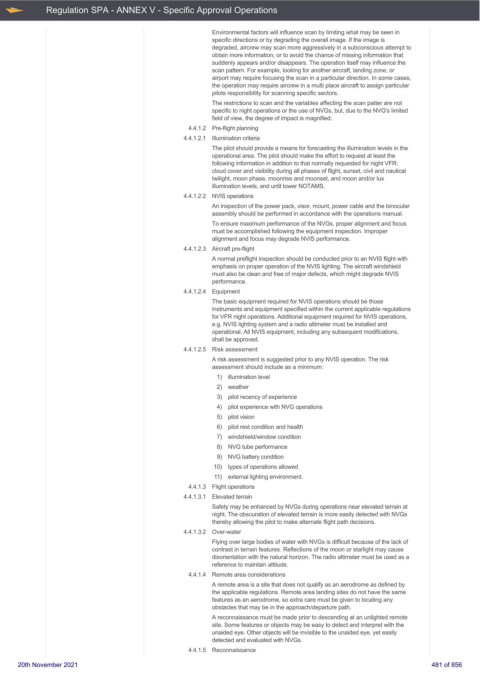Page 481 - UK Air Operations Regulations (Consolidated) 201121
P. 481
~
~ Regulation SPA - ANNEX V - Specific Approval Operations Centrik
Environmental factors will influence scan by limiting what may be seen in
specific directions or by degrading the overall image. If the image is
degraded, aircrew may scan more aggressively in a subconscious attempt to
obtain more information, or to avoid the chance of missing information that
suddenly appears and/or disappears. The operation itself may influence the
scan pattern. For example, looking for another aircraft, landing zone, or
airport may require focusing the scan in a particular direction. In some cases,
the operation may require aircrew in a multi place aircraft to assign particular
pilots responsibility for scanning specific sectors.
The restrictions to scan and the variables affecting the scan patter are not
specific to night operations or the use of NVGs, but, due to the NVG's limited
field of view, the degree of impact is magnified.
4.4.1.2 Pre-flight planning
4.4.1.2.1 Illumination criteria
The pilot should provide a means for forecasting the illumination levels in the
operational area. The pilot should make the effort to request at least the
following information in addition to that normally requested for night VFR:
cloud cover and visibility during all phases of flight, sunset, civil and nautical
twilight, moon phase, moonrise and moonset, and moon and/or lux
illumination levels, and unlit tower NOTAMS.
4.4.1.2.2 NVIS operations
An inspection of the power pack, visor, mount, power cable and the binocular
assembly should be performed in accordance with the operations manual.
To ensure maximum performance of the NVGs, proper alignment and focus
must be accomplished following the equipment inspection. Improper
alignment and focus may degrade NVIS performance.
4.4.1.2.3 Aircraft pre-flight
A normal preflight inspection should be conducted prior to an NVIS flight with
emphasis on proper operation of the NVIS lighting. The aircraft windshield
must also be clean and free of major defects, which might degrade NVIS
performance.
4.4.1.2.4 Equipment
The basic equipment required for NVIS operations should be those
instruments and equipment specified within the current applicable regulations
for VFR night operations. Additional equipment required for NVIS operations,
e.g. NVIS lighting system and a radio altimeter must be installed and
operational. All NVIS equipment, including any subsequent modifications,
shall be approved.
4.4.1.2.5 Risk assessment
A risk assessment is suggested prior to any NVIS operation. The risk
assessment should include as a minimum:
1) illumination level
2) weather
3) pilot recency of experience
4) pilot experience with NVG operations
5) pilot vision
6) pilot rest condition and health
7) windshield/window condition
8) NVG tube performance
9) NVG battery condition
10) types of operations allowed
11) external lighting environment.
4.4.1.3 Flight operations
4.4.1.3.1 Elevated terrain
Safety may be enhanced by NVGs during operations near elevated terrain at
night. The obscuration of elevated terrain is more easily detected with NVGs
thereby allowing the pilot to make alternate flight path decisions.
4.4.1.3.2 Over-water
Flying over large bodies of water with NVGs is difficult because of the lack of
contrast in terrain features. Reflections of the moon or starlight may cause
disorientation with the natural horizon. The radio altimeter must be used as a
reference to maintain altitude.
4.4.1.4 Remote area considerations
A remote area is a site that does not qualify as an aerodrome as defined by
the applicable regulations. Remote area landing sites do not have the same
features as an aerodrome, so extra care must be given to locating any
obstacles that may be in the approach/departure path.
A reconnaissance must be made prior to descending at an unlighted remote
site. Some features or objects may be easy to detect and interpret with the
unaided eye. Other objects will be invisible to the unaided eye, yet easily
detected and evaluated with NVGs.
4.4.1.5 Reconnaissance
20th November 2021 481 of 856

